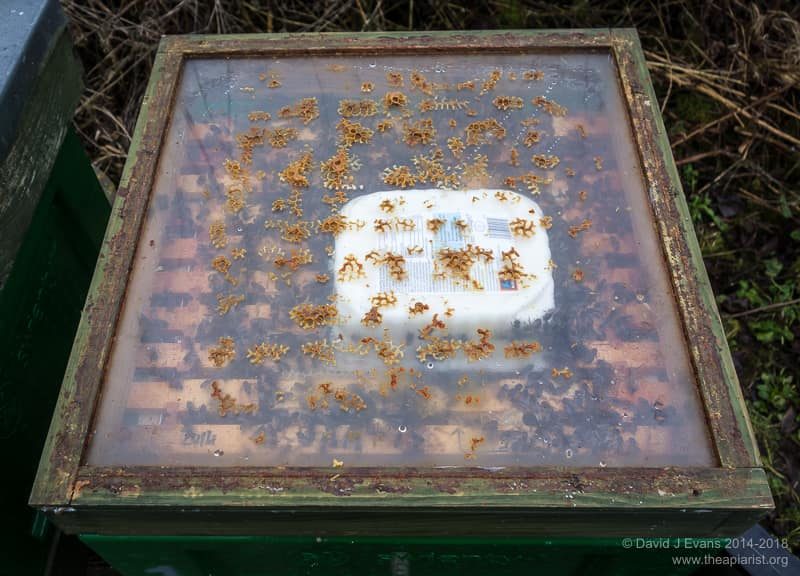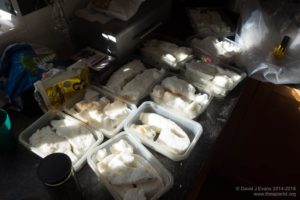Fondant topups
Perhaps surprisingly if the weather is still very wintery, inside your hives brood rearing has probably started {{1}}. It’s about half way through the winter, there’s no forage available and the colonies are surviving on the stores they laid down in the autumn last year.
But now they have a few more mouths to feed … as a consequence, they’re likely to start using the stores at a higher rate.
I’ve recently written about the importance of hefting hives in the winter to judge (very approximately) how much stores they have remaining. It’s an imprecise science at the best of times, but it is important to ensure they don’t run out.
If they do, the colony will starve to death.
Fondant topups
If the colony is feeling a bit light you need to give it sugar as soon as practical and as close to the clustered bees as possible. The most convenient type of sugar to give is bakers fondant. This is the same stuff you get on Chelsea buns. You can buy fondant in 12.5 kg blocks for about a tenner (in bulk … one-off purchases are likely to be more expensive) from wholesale suppliers.
Fondant keeps well for several years and so it’s worth stockpiling some for emergencies. Since I use fondant for all my autumn feeding as well I buy in bulk (200+ kg) every year or two and stack it somewhere safe, dry and protected from vermin (and other beekeepers ? ).
Feeding fondant can be as simple as cutting a thick slice of fondant off the block and laying it across the top bars of the hive. You’ll need an eke or a reversible crownboard to provide the ‘headspace’ over the colony. Replace the roof and any insulation and the colony should be OK … but don’t stop checking for the rest of the winter.
Don’t be stingy and don’t delay
It’s not worth adding a measly few ounces of fondant. If it’s midwinter and the colony is already light, a couple of hundred grams is going to only last a few days.
Don’t be stingy. Add at least a couple of kilograms.
Don’t wait for a balmy midwinter day to add the fondant. Add it as soon as you realise they’re light. It won’t harm the colony to open it up for the few seconds it takes to add the block.
Wear a veil … some colonies can be semi-torpid, others can be quite feisty. How would you feel about having the roof ripped off on a grey midwinter afternoon? You might be trying to save them from starvation, but their reaction might be something a little less than appreciative ?
Add the fondant as close to the clustered bees as possible. A small cluster cannot move far in very cold weather. Even inches is too much. There are few sights more tragic than a cluster of starved bees just a few centimetres from lashings of sealed stores or a large lump of fondant.
Finally, don’t spend ages clearing bees off the top bars with little puffs of smoke. The colony will be getting chilled and the disturbance will be worse than the loss of the few bees you might inadvertently squash under the fondant block.
Think of the greater good … speaking of which.
Takeaways
When I feed colonies in the autumn I simply slice a complete block of fondant in half with a spade, open it like a book and lay it on top of the colony. With smaller amounts you can use a breadknife to (carefully … mind your fingers!) cut the block up. It’s a lot easier if the block is at room temperature.
For real convenience you can pack plastic food trays with fondant, wrap them in clingfilm and take a couple with you when you visit the apiary. If needed, simply unwrap them and invert them over the top bars of the hive. Large takeaway food containers or one of the many semi-solid types of plastic packaging used by supermarkets are ideal. Tortellini packets are good and just about fit the ekes I’ve built.
Wash them thoroughly before use rather than subjecting your bees to last nights Chef’s Special Chow Mein ?
Finally, remove the clingfilm completely before use. Bees tend to chew through clingfilm and drag it down into the broodnest, even incorporating it into the bits of brace comb they build. Getting rid of the traces of clingfilm during the first spring inspection is a pain, and best avoided.
{{1}}: Usual caveat here … I’m based in Eastern Scotland and it can be very, er, temperate here. If you live in Dorset, or the Dordogne or Doha, you may well never have a broodless period.


Join the discussion ...